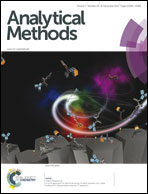A seaweed–polyaniline nanofibre modified electrode for sensing of uric acid
Abstract
In this paper, seaweed–polyaniline (SE–PANI) nanofibres were prepared through a polymerization of aniline hydrochloride in the presence of seaweed extract (SE) and ammonium persulphate (APS) used as an oxidant. The resultant SE–PANI nanofibres were characterized by different techniques such as Fourier transform infrared spectroscopy, ultra violet-visible spectroscopy, X-ray diffraction, high resolution scanning electron microscopy and Brunauer–Emmett–Teller analysis. The thermal stability of the SE–PANI nanofibres was higher than that of pristine PANI, confirmed by thermogravimetric analysis and differential thermal analysis. Electrochemical measurements of the SE–PANI nanofibres were carried out using cyclic voltammetry and electro-chemical impedance spectroscopy. A SE–PANI/GCE modified electrode shows a better electrocatalytic activity for uric acid (UA) with a lower potential and a larger peak current than the pristine PANI modified glassy carbon electrode. DPV studies revealed that the fabricated electrode had excellent sensitivity for uric acid with a lowest detection limit of 0.104 μM over a wide concentration range of 5 × 10−5 to 5 × 10−3 M.


 Please wait while we load your content...
Please wait while we load your content...